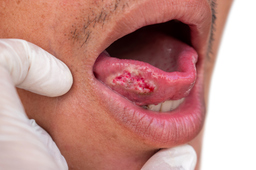Janus Particle Based Oral Cancer Chemopreventive Rinse with Oral Mucosal Substantivity
TECHNOLOGY NUMBER: 7186

OVERVIEW
Nanoparticle compositions of two or more agents for chemoprevention of cancers- Useful for decreased recurrence of oral squamous cell carcinomas (OSCC)
- May inhibit progression of oral intraepithelial neoplasm (OIC) into true neoplasms
BACKGROUND
Squamous cell carcinoma of the oral cavity affects up to 50,000 patients in the United States each year, and surgical excision with adjuvant chemoradiotherapy, as needed, can cause significant side effects while still yielding significant rates of local recurrence. About one-third of these patients die from the effects of locally recurrent tumors, especially in the setting of oral squamous cell carcinoma (OSCC) neoplasms that do not associate with the prognostically favorable human papilloma virus infection. OSCC tumors commonly arise from the malignant progression of precursor lesions such as oral intraepithelial neoplasia (OIN). About 85% of OIN lesions transform to true neoplasms over time, and 30% of completely resected OIN abnormalities recur following surgery. Attempts to improve clinical outcomes in this setting with single agent chemopreventative trials have resulted in disappointingly low success rates with unacceptably high side effect risks. As such, a need exists to identify new chemoprotective strategies to help prevent the recurrence of OSCC tumors and to also diminish the risk for progression of OIC to OSCC neoplasms.
INNOVATION
Researchers have discovered nanoparticle compositions which may be used for chemoprevention of cancers, such as oral squamous cell carcinoma (OSCC) tumors. The nanoparticle composition is comprised of a Janus particle which combines at least two chemopreventative agents, at least one of which is selected from sources including freeze-dried black raspberries (BRB), a synthetic vitamin A analogue, N-acetylcysteine (NAC), and an anti-interleukin 6 agent. The compositions may be delivered orally with a low risk of side effects, or they may alternatively be administered in an oral rinse, troche, topical gel, or mucoadhesive patch formulation. The agents may be administered either with the goal of preventing recurrence of a treated OSCC or inhibiting the progression of a precancerous lesion into a neoplasm. The invention may alternatively provide protection against the formation of periodontal disease.